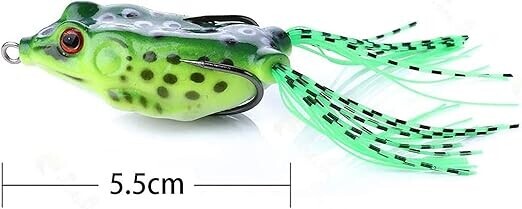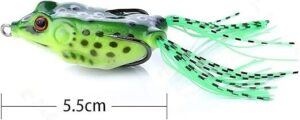How To Hook Set With A Frog
Top water frog lures have earned a special place in the tackle boxes of many anglers, especially those on the hunt for bass. These lures mimic the fluttering movement of a frog on the water’s surface, triggering a bass’s natural hunting instincts. It’s like waving a red flag in front of a bull—something just snaps, and suddenly, you’ve got a fight on your hands.
One major perk with using these froggy lures is how they shine in heavy vegetation. Spots where other lures might get snagged are where these guys come alive. They skim over lily pads and weed beds, promising a clean pass without getting tangled. Think of them as the perfect guerrilla tactic in your fishing playbook, sneaking in where others can’t tread.

Diving into the types of top water frogs, you’ve got your basic models and the more advanced options with fancy skirts or realistic enhancements. Some are built for popping, creating little explosions on the water’s surface that drive fish wild. Others glide smoothly, a stealthier approach for calmer days. Each type offers something different, so knowing their strengths can make or break your day on the water.
What makes top water frogs truly convincing is their ability to mimic natural prey. Whether it’s the sight of a lone frog struggling across an open stretch or the sound of its feet hitting the water, these lures tap into the primal drive of predator fish. Even when the bass aren’t hungry, a well-presented frog can trigger a reaction strike, just out of pure instinct.
Choosing the Right Gear for Frog Fishing
Finding the right gear for frog fishing is kind of like building a toolbox for specific tasks. Assembling the essentials involves a deep understanding of what each component brings to the table.
Start with the rod and reel. You want a setup offering the right balance of power and control. Think about a medium-heavy to heavy rod around 7 to 8 feet in length. This length gives you the leverage needed to handle a big bass that’s reluctant to let go once it’s grabbed a hold of your frog. A fast action tip helps with control and sensitivity, allowing you to feel the subtle strikes and set the hook with authority.
When it comes to reels, a high-speed baitcaster reel is your best friend here. You need quick line retrieval to keep the tension when a fish makes a run at your lure, especially in those heavy cover areas where a slow reel could mean a lost catch. A reel with a 7:1 gear ratio or higher will usually do the trick.
Choosing the right fishing line is another crucial part. Braided line, generally in the 50 to 65-pound range, is the preferred choice. It’s designed for strength and abrasion resistance, cutting through vegetation without a hitch. Unlike monofilament, it doesn’t have much stretch, ensuring immediate response when setting the hook.
Lastly, you can’t overlook the importance of selecting the right frog lures based on the conditions you’ll face. Different structures and cover situations dictate the type of frog you might want to use—some feature heavy weights for punching through thick mats, while others have long trailing skirts for open water situations. It’s all about matching your lure to the natural environment and the mood of your target fish.
Mastering the Art of Casting with Frog Lures
Casting with frog lures requires a blend of precision, strength, and a bit of finesse. It’s not as simple as just whipping the lure out there; it’s more of an art form that demands attention to detail.
One technique that stands out in tricky environments is the roll cast. This method helps you keep your lure low to the water, slipping it through that tight window between branches or other obstacles. It’s all about smooth, controlled movements—think of it like loading a spring before letting it snap.
Accuracy is king when you’re casting near cover. A precise cast lands your frog exactly where you want it, reducing the chance of getting stuck in debris while maximizing your chances of a strike. Focus on your release timing and wrist action to naturally guide your lure where it needs to go.
Avoid common casting mistakes such as arcing your casts too high or throwing with excessive force. These mistakes can lead to off-target casts or the dreaded lure splashdown that scares fish away. Keep it gentle but firm, and always be mindful of the sound your lure makes when it hits the water.
To get the distance and precision you need, try incorporating a pause at the peak of your back cast. This pause helps load the rod with enough potential energy to whip the lure out further, giving you that extra reach necessary to access those tricky spots where bass love to hide.
Executing a Hook Set When Using Frogs
Setting the hook with frog lures involves a bit of patience and discipline. When a bass strikes, there’s often a split-second decision required to make sure your catch doesn’t get away.
Resist the urge to yank immediately when you see a blowup. It might feel instinctive to react quickly, but waiting just a moment longer can make all the difference. Count to two, then set the hook hard. You’re letting the bass truly chomp down on the lure before giving it the old heave-ho.
Take note of fish behavior. Sometimes bass hit out of aggression, and sometimes they’re just investigating. By observing carefully, you’ll learn patterns and refine your timing on the hook set.
Perfecting the hook set is all about timing and power. Make sure your rod tip is down right from the start. When the time comes, sweep the rod back with a single, smooth motion, using your whole body to add power to the set.
Avoid common pitfalls like slack in your line or a weak hook set. Maintaining tension is crucial, especially when navigating through vegetation. Slack gives the fish room to spit out the lure before you know it. So, keep it tight and make each hook set count.
Walking the Frog: Techniques for Success
“Walking the dog” isn’t just a catchphrase in this context; it’s a time-tested technique that turns your frog lure into a tempting target. By twitching the rod tip, you create a zigzag pattern that mimics the erratic movements of prey, enticing bass into a strike.
When weaving through weed beds, gentle rod twitches with pauses in between can mean the difference between a curious look and a committed strike. It’s about figuring out the rhythm that bass in that particular body of water can’t resist.
Adjust your retrieve based on the conditions. On days when the water is choppy, a slower, more deliberate zigzag can catch more attention. In calmer waters, speeding things up could just be what triggers that reaction strike.
Mastering this technique means fine-tuning how you reel in line. A steady reel in combo with rhythmic rod knocks is how you maintain that seamless back-and-forth movement. It might take some practice, but once nailed down, it pays off in spades.
Lastly, keep your eyes glued to any swirl or splash around your lure. Be ready to pause your retrieve and prepare for that perfect moment to set the hook. As always, each cast is a new chance to adjust and perfect your approach.


